In addition to adding in curries, lentils, etc., one of the most common ways of using tomatoes or tamatar in Indian cuisine is in the form of a condiment or Chutney. Chutneys are common in most of the Indian homes. Along with the famous Coconut Chutney, even the Tomato Chutney recipe has many variations pan India. This post of mine has two versions of the South Indian style chutney, also known as Thakkali Chutney, made with fresh tomatoes, spices and herbs. Make these at home, and enjoy it with Idli, Dosa or as a relish, spread, with your meals.
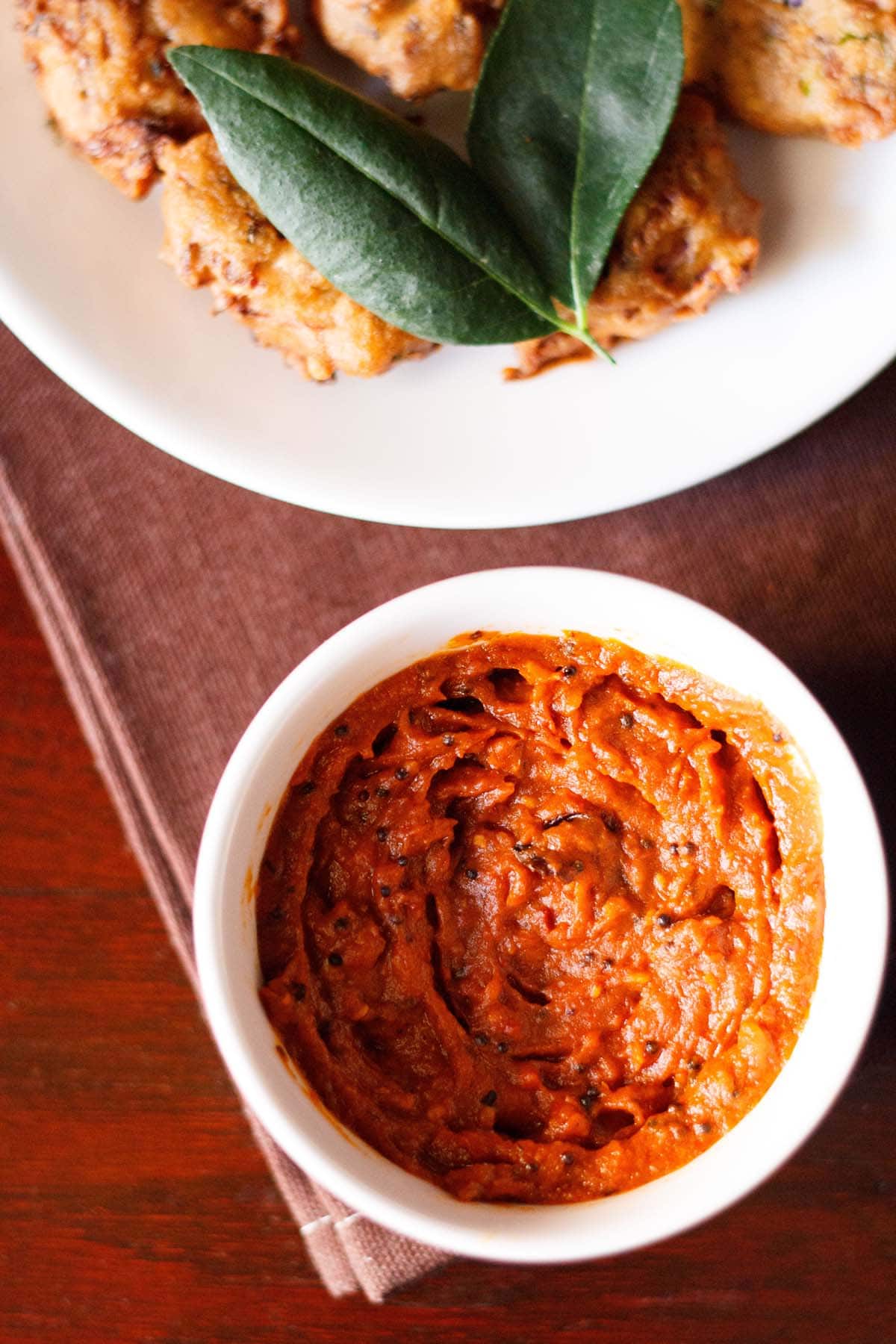
About Tomato Chutney Recipe
The first variation is this simple Tomato Chutney which has no onion or garlic and is tempered with basic spices. The use of ginger in this Tamatar ki Chutney brings an earthy flavor to it. It really pairs well with the fresh, plump and tart tomatoes.
In addition to the tangy taste of tomatoes, one more ingredient which gives this Thakkali Chutney its distinct aroma and warm flavor is the use of cloves (laung/lavang). I have added just about 2 cloves, which imparted a strong aroma to the chutney.
Table of Contents
If you wish to have a less dominant taste and fragrance of cloves in the Tomato Chutney, you can reduce the quantity to one or skip it entirely. However, keep in mind that the aroma of the chutney does mellow down once you refrigerate it.
Also, as mentioned earlier, this is a Tomato Chutney recipe sans onion and garlic. But if you wish to add both these, you can go ahead with it. There’s no harm in doing so, as it only makes the chutney lovelier.
This spice, tangy and delectable Thakkali Chutney is best had with South Indian snacks like Idli, Dosa, Medu Vada, uttapam, and pakoda varieties.
How to make Tomato Chutney
Recipe 1
Cook and Blend Tomatoes
1. Heat 1 tablespoon oil in a frying pan or sauté pan, and add 1 teaspoon urad dal (split husked black gram).
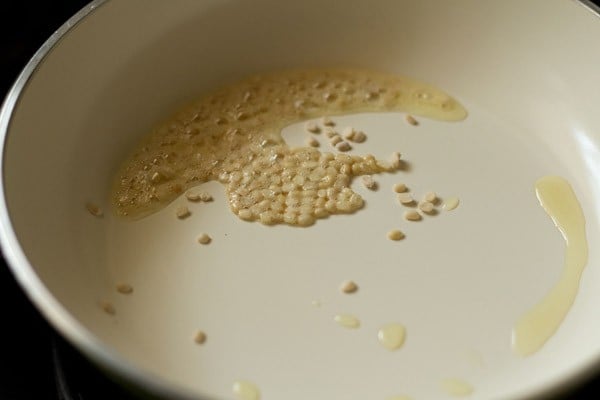
2. On low heat, fry the urad dal till the lentils starts turning a maroonish brown.
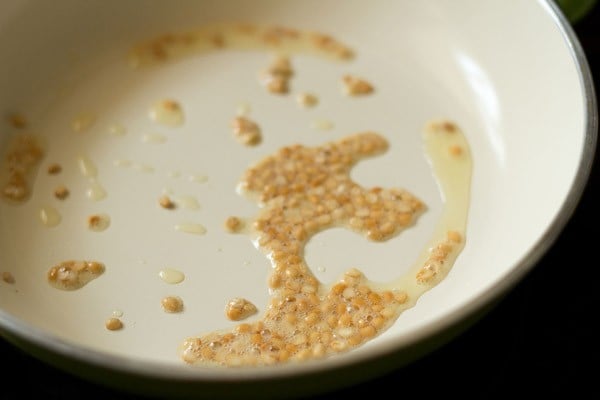
3. Once the lentils get a maroonish brown color, add 2 to 3 broken dried red chilies, 2 to 3 cloves, 4 to 5 black peppercorns and 1 inch peeled and chopped ginger.
Stir and sauté till the red chilies change color and become a shade darker, but ensure not to burn any spices or even the chillies.
I have used here red chillies which are not spicy or hot and hence added 3 of them. If using hotter and pungent varieties of red chilli, add 1 or ½ of it.
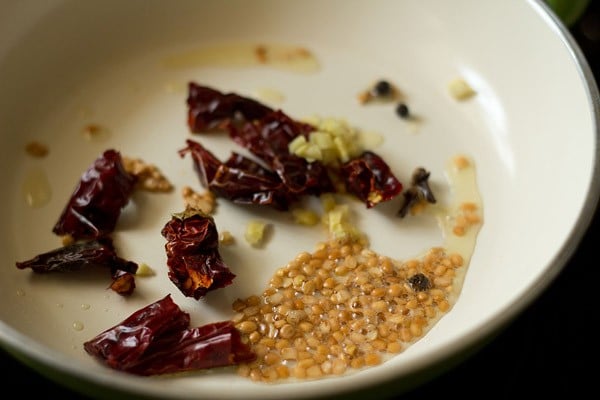
4. Then, add 1.5 cups chopped tomatoes (or 2 large tomatoes) and a pinch of asafoetida (hing).
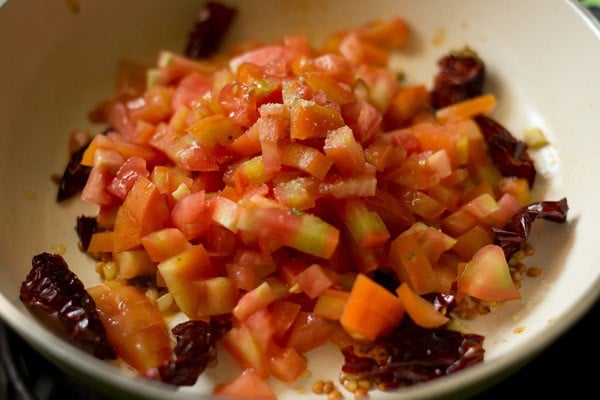
5. Add salt as required.
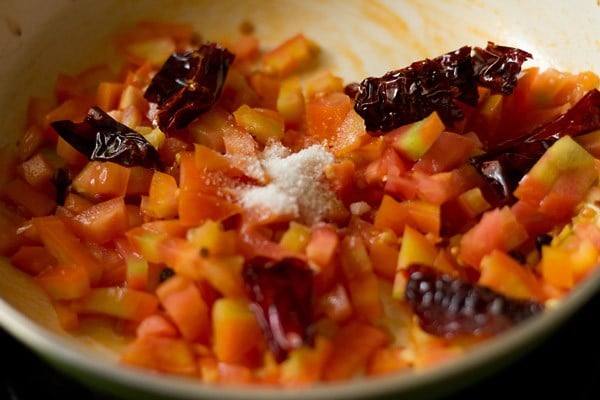
6. Stir and sauté till the tomatoes soften. About 6 to 7 minutes on low to medium-low heat.
When the tomatoes have softened and cooked well, turn off the heat and set aside the sautéed chutney ingredients to cool.
Ensure that the tomatoes have softened nicely, as if they remain raw or undercooked, there will be the raw taste and flavor of tomatoes in the chutney.
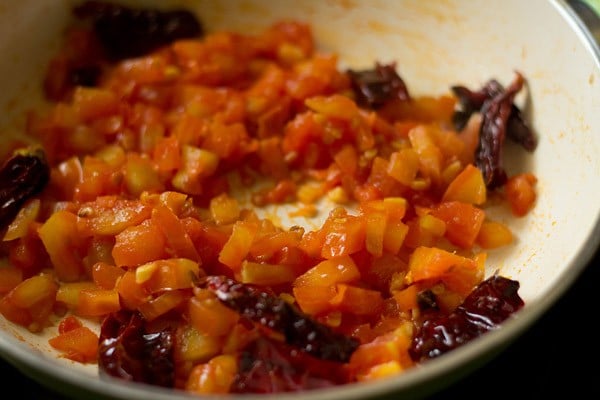
7. Once the tomato mixture cools, add it to a chutney grinder or a small blender. Add 2 tablespoons water and grind to a smooth and fine consistency.
You can also add 1 or 2 tablespoons more water if needed.
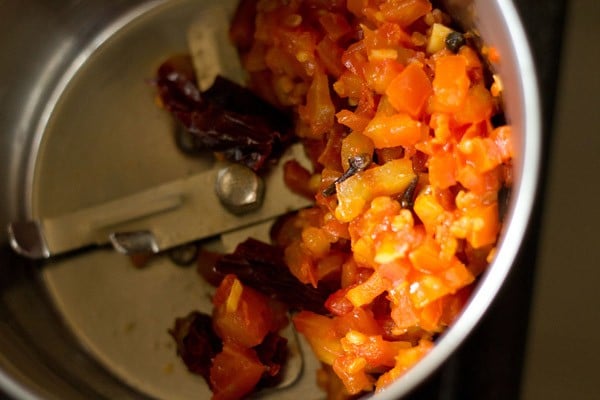
Temper
8. In the same pan or a different pan, heat ½ tablespoon oil. Add ½ teaspoon mustard seeds and let them crackle.
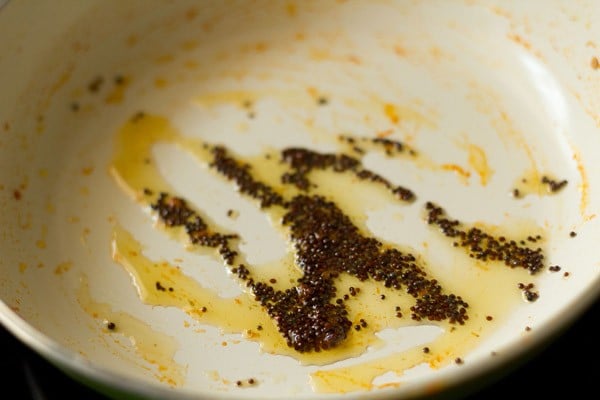
9. Then, add 7 to 8 curry leaves, 2 to 3 fenugreek seeds (methi seeds), a pinch asafoetida and 1 broken dried red chili (stem and seeds removed).
Mix and sauté till the curry leaves become crisp.
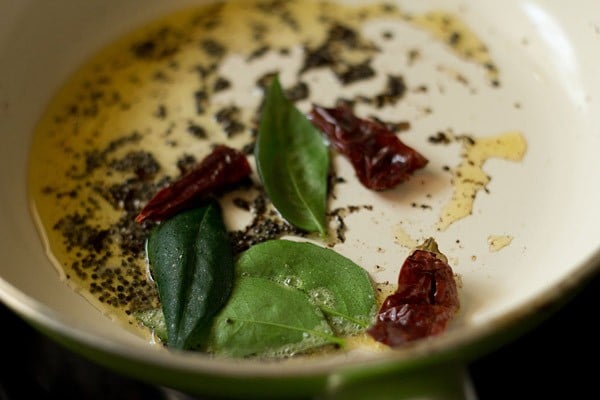
10. Then, add the prepared tomato paste.
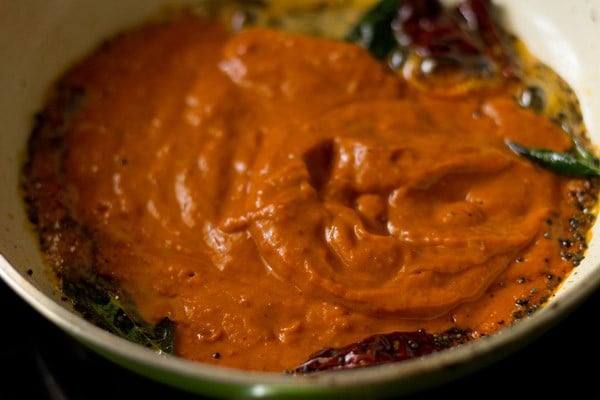
11. Mix thoroughly.
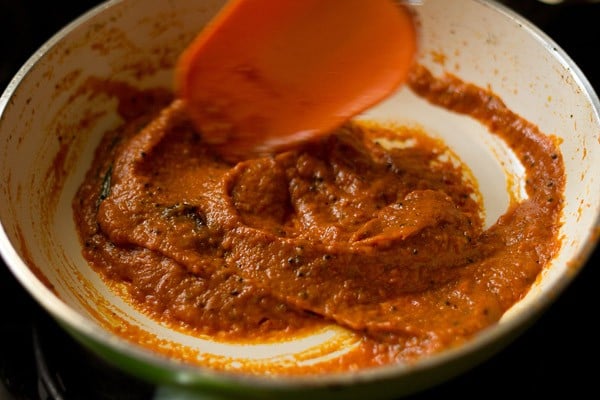
12. Sauté for 3 to 4 minutes on low heat. If the chutney has become thick for your liking, add a splash of hot water to loosen the consistency a bit.
You can easily adjust the consistency from thick to medium, by adding water as needed.
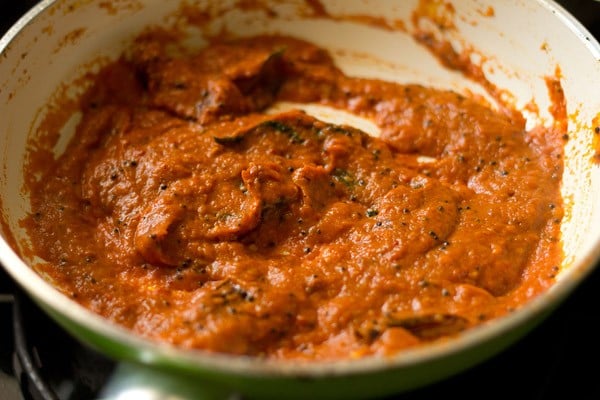
13. Check the taste and add more salt if required.
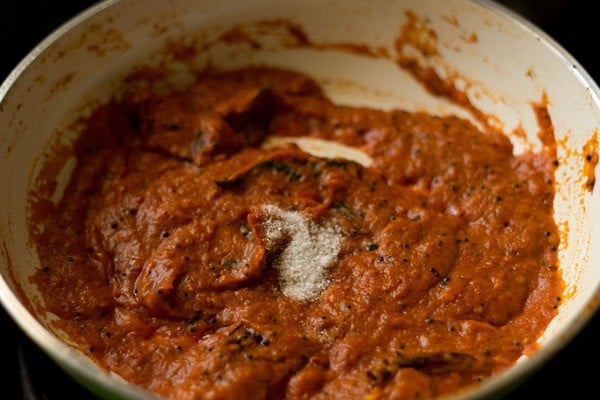
14. Mix again. Transfer the Tomato Chutney to a bowl and you are now ready to serve it. You can serve it warm or at room temperature.
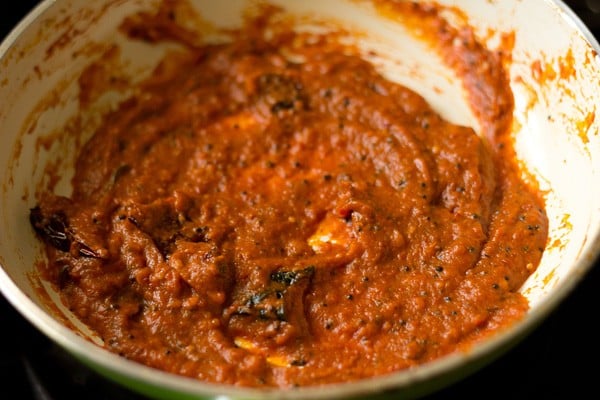
Serving and Storage Suggestions
The Tomato Chutney is done and ready to be served with breakfast dishes or snacks like idli, dosa, uttapam, medu vada or appe.
You can also serve it with evening snacks like masala vada, onion bajji or pakoda, potato pakora and many other pakora variants etc.
This chutney can also be used as a spread on your chapati, dosa, bread toast or paratha. You can also serve it a side chutney condiment with rice in your meals.
Store any leftover chutney in the refrigerator for 1 to 2 days. Keep it in an airtight container in the fridge.
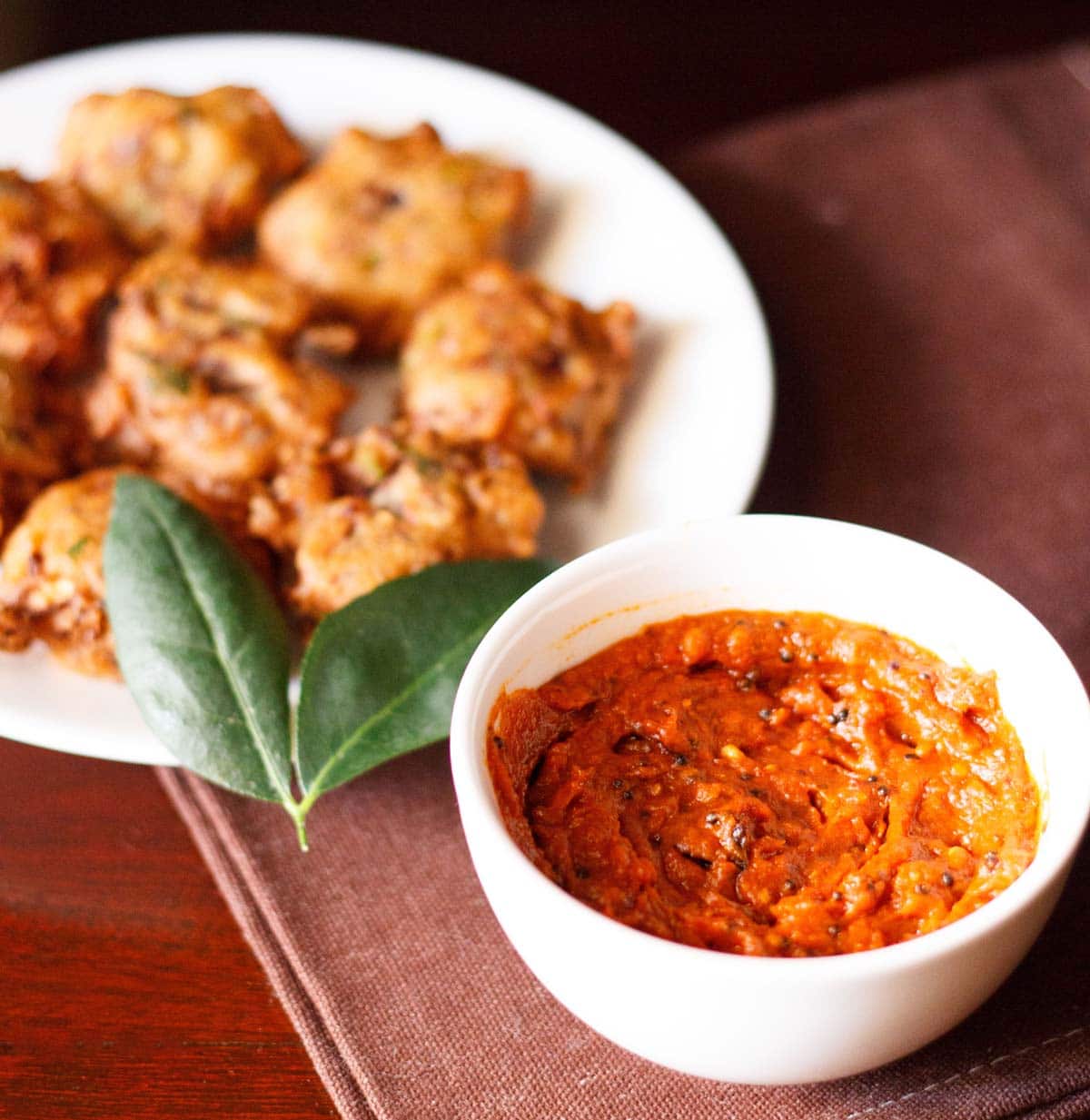
Variations
This Tomato Chutney has the main ingredient as tomatoes. While you are at this recipe, giving it a try and then making it a favorite of all your family members, I really want you to try a few more chutneys that have tomatoes in them.
These chutney recipes are also super easy and make for a great condiment during your lunches, dinner or snack parties at home. Some of them are:
- Kara Chutney – This spicy chutney made with shallots, tomatoes, spices and herbs is a special from the cuisine of Tamil Nadu. Can be considered as the close cousin of the other onion tomato chutney recipe that I’m going to mention in this post itself.
- Tomato Pachadi – This is a Thakkali Pachadi or the Thakkali Chutney, a delicacy from Andhra cuisine. The flavor profile of this chutney is spicy, sour and tangy. You’ll really miss on something fab, if you don’t give this a try.
- Tomato Thokku – A South Indian recipe of a kind of tomato pickle or relish is this condiment. Usually served as a side relish with steamed rice, this spiced condiment is made with tomatoes, tamarind, herbs and spices.
- Tomato Khejur Chutney – This is almost a dessertish sweet and spiced chutney of tomatoes, dates and Panch Phoron, a revered delicacy from Bengali cuisine. The classic way of having this variation is to pair it with the Bengali Khichdi.
- Momos Chutney – This is my take on the quintessential spicy, red sauce that is served with momos (steamed dumplings) across the country. I have also used tomatoes along with the red chilies and garlic cloves in this recipe. This will surely level up your experience of relishing momos at home.
About Onion Tomato Chutney Recipe
Recipe 2
The second variation to the original Thakkali Chutney is this easy Onion Tomato Chutney. You can alter the taste a bit here and there by just playing with the proportions of the onions, tomatoes, dried red chilies and tamarind in this recipe.
I have used an equal proportion in weight of the onions and tomatoes for this recipe variation. Also, there’s no tempering (or tadka) in this chutney as it tastes great even without it.
But you can definitely make it more flavorsome by adding a temper of mustard seeds, dried red chilies and curry leaves at the end.
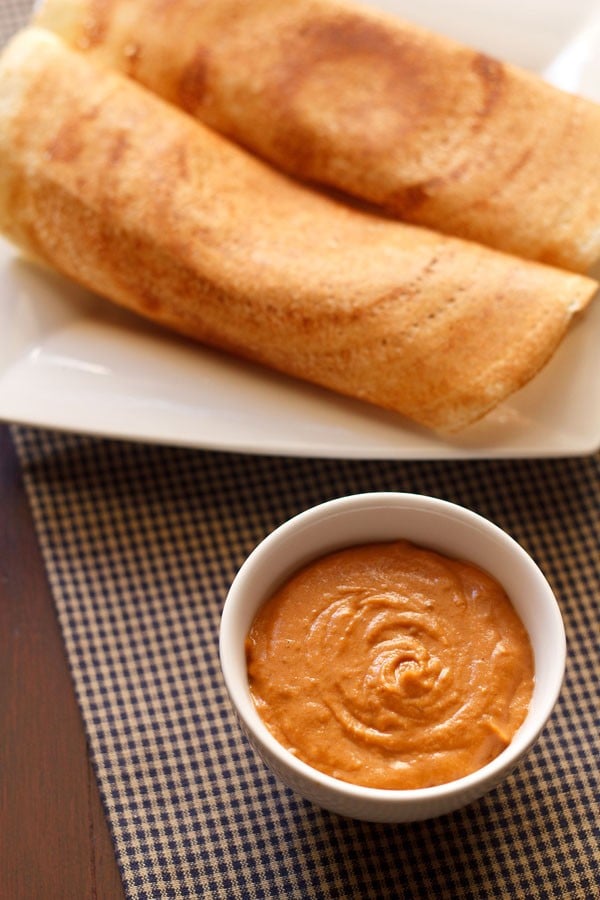
At home, I usually serve this version of the onion based Thakkali Chutney with crispy dosa or soft and light idli.
Ingredients
- 1 cup chopped onions, 100 grams or 2 medium-sized
- 1 cup chopped tomatoes, 100 grams tomatoes or 2 medium-sized
- ½ teaspoon urad dal (spilt and husked black gram)
- 1 to 2 dry red red chilies – kept whole or broken, deseeded if you prefer
- 1 pinch asafoetida (hing)
- 1 small piece of tamarind – approximate ½ teaspoon of seedless tightly packed tamarind
- 1 tablespoon sunflower oil or peanut oil or sesame oil – not the asian variety of sesame oil
- salt as required
- water as required for blending or grinding the chutney ingredients, optional
Instructions
1. Heat 1 tablespoon sunflower oil (or peanut oil) and add ½ teaspoon urad dal. Keep heat to low or medium-low.
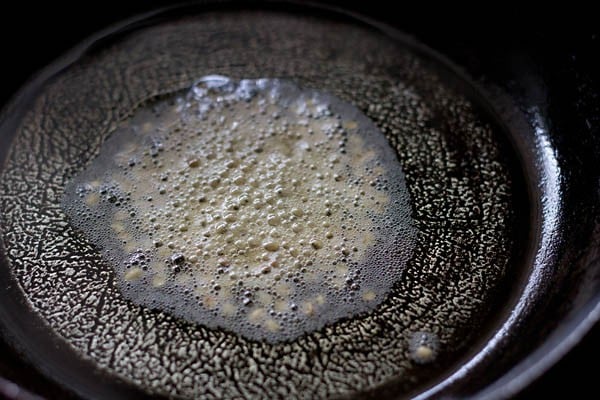
2. Once the lentils start to become light brown, add 1 to 2 dried red chilies.
So, by the time the urad dal turns to a maroonish color, the red chilies would also have changed color. Make sure you don’t burn them.
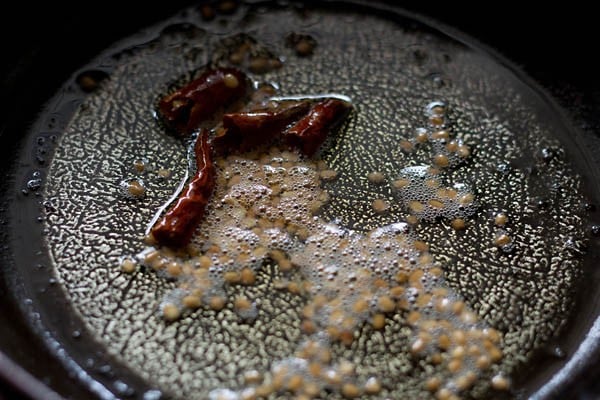
3. Add the chopped onions and sauté stirring often, until they turn light golden.
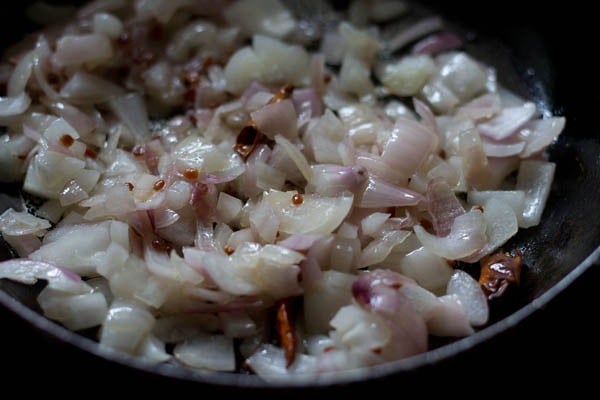
4. When the onions become light golden, add the chopped tomatoes, a pinch of asafoetida and salt as required.
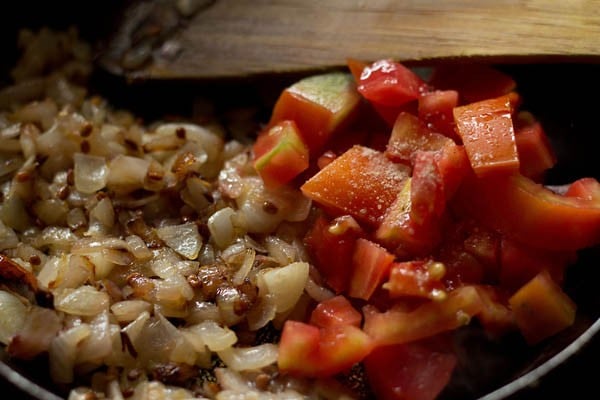
5. Stir and sauté till the tomatoes soften and get cooked. This step is important as you don’t want the raw aroma of tomatoes in the chutney.
If the tomatoes start sticking to the pan, then sprinkle some water on them and continue to sauté.
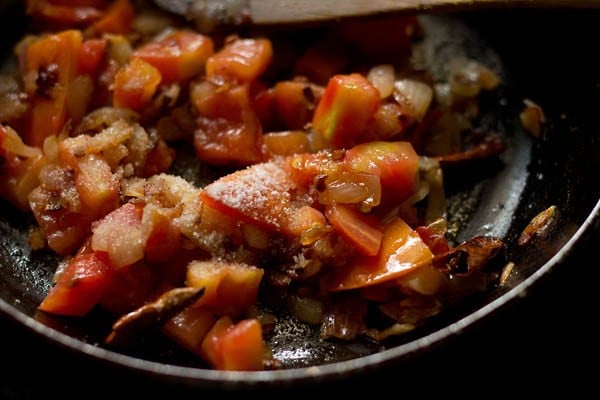
6. So, as you see in the photo below, the tomatoes have cooked and softened.
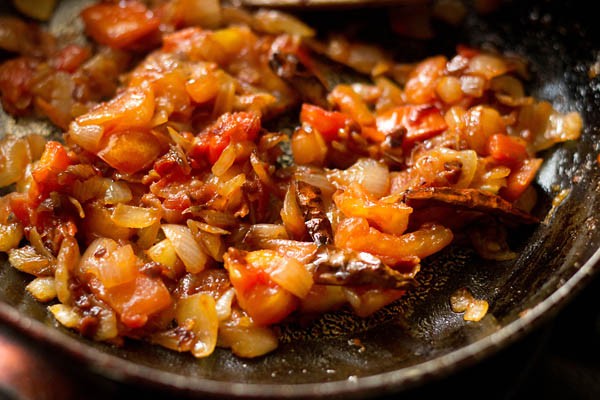
7. Let the onion tomato chutney mixture become warm or cool. Later, add the sautéed ingredients a chutney grinder or a small blender jar.
Add a small piece of tamarind (approximately ½ teaspoon of seedless tightly packed tamarind) too.
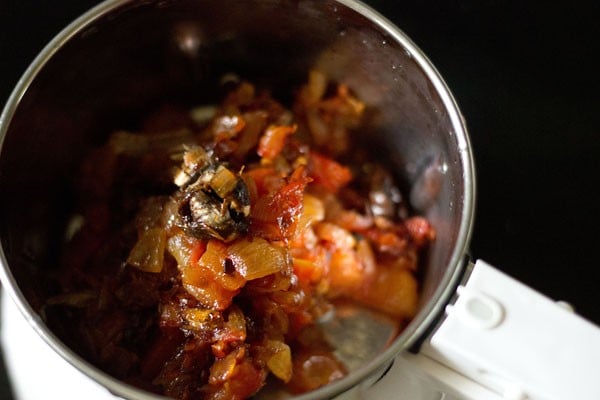
8. Without adding any water, grind the ingredients to a smooth and fine chutney. You can also make it semi-coarse, if you prefer. If you are unable to grind, then add a few tablespoons of water.
Do a taste test and add some more salt or tamarind if required and continue to grind to a fine consistency. Transfer to a serving bowl.
As I have mentioned above, you could opt to temper the onion tomato chutney with mustard seeds, dry red chilies and curry leaves. But without the tempering too, this tangy chutney tastes good.
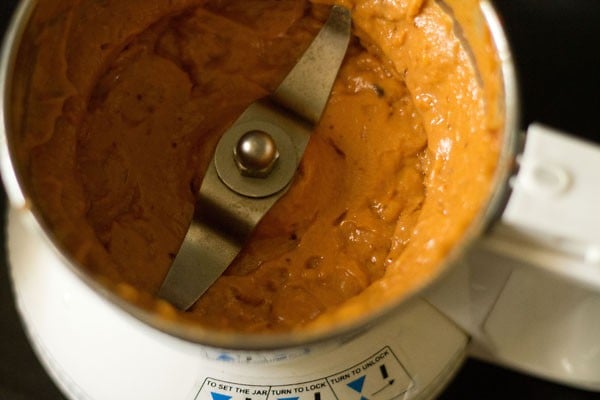
9. Serve the Onion Tomato Chutney as an accompaniment with idli, dosa or medu vada.
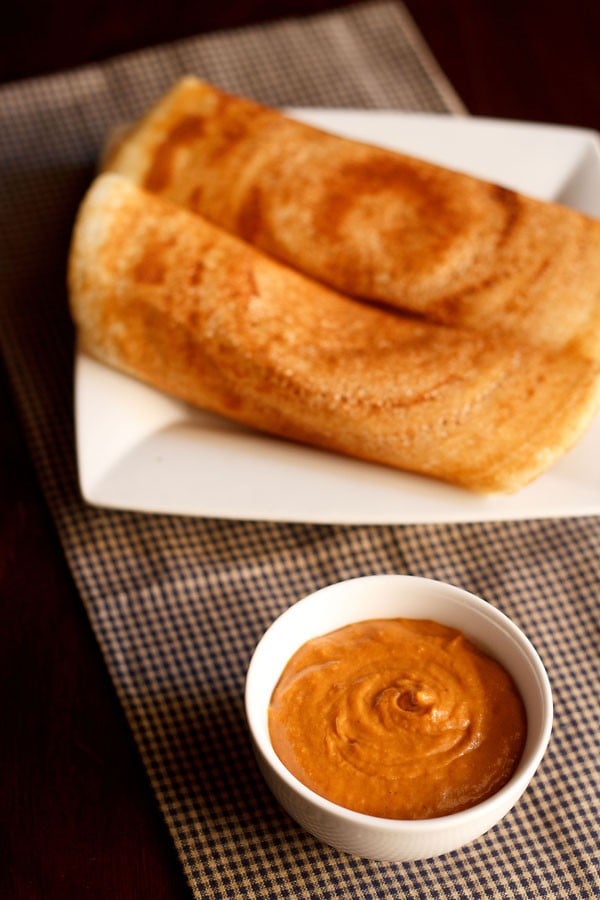
Expert Tips
- You must cook the tomatoes (whichever recipe you choose), till they nicely soften and are cooked through. This is important as you really don’t want the raw aroma or flavor of the tomatoes in the chutneys.
- If the tomatoes stick to the pan while cooking, sprinkle some water and continue to cook.
- For the Onion Tomato Chutney, you can grind the chutney without any water till smooth. A semi coarse texture is also good in the chutney. If unable to grind, then add some water.
- Alternatively for the Onion Tomato Chutney, you can omit adding tamarind. Or use a bit of tamarind pulp or tamarind paste.
- For a spicier taste in either of the recipes, use 1 dry red chilli which is high in heat or increase the number of chillies if using lower or medium heat varieties.
- Keep the consistency thick or medium, by adding water as needed.
- Both the recipes can be scaled to make for more servings.
More Chutney Recipes To Try!
Chutney Recipes
Chutney Recipes
Chutney Recipes
Chutney Recipes
Please be sure to rate the recipe in the recipe card or leave a comment below if you have made it. For more vegetarian inspirations, Sign Up for my emails or follow me on Instagram, Youtube, Facebook, Pinterest or Twitter.
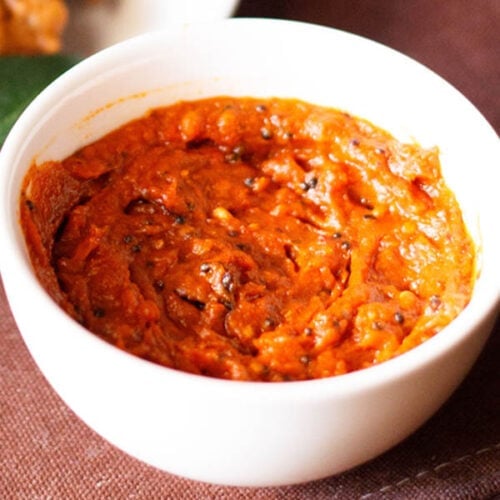
Tomato Chutney Recipe For Idli & Dosa
Ingredients
To Cook and Blend
- 1 tablespoon oil
- 1 teaspoon urad dal (split and husked black gram)
- 2 to 3 dry red chillies – broken and deseeded, I have used less hot variety of red chillies. Check point no 4 in notes.
- 1 to 2 cloves – optional
- 4 to 5 black peppercorns
- 1 inch ginger – peeled and chopped
- 1.5 cups tomatoes chopped, 225 to 250 grams or 2 large tomatoes
- 1 pinch asafoetida (hing) – optional
- salt as required
- 2 tablespoons water – for blending or grinding, add 1 or 2 tablespoon more if needed
To Temper
- ½ tablespoon oil – sesame oil or sunflower oil or any neutral flavored oil
- ½ teaspoon mustard seeds
- 7 to 8 curry leaves
- 2 to 3 fenugreek seeds (methi seeds)
- 1 pinch asafoetida (hing)
- 1 dry red chili – halved and deseeded
Instructions
Cooking and blending tomatoes
- In a frying pan or sauté pan, heat 1 tablespoon oil and add urad dal. On a low heat, fry the urad lentils till they start turning maroonish.
- Once the lentils get a maroonish brown color, add broken dry red chilies, cloves, black peppercorns and chopped ginger. Stir for some seconds, till the red chilies change their color.
- Then add chopped tomatoes and asafoetida. Add salt.
- Stir and saute till the tomatoes soften. About 6 to 7 minutes on a low to medium-low heat.
- If the tomatoes start sticking to the pan, add a splash of water and continue to sauté.
- After the tomatoes have softened, turn off the heat and set aside the chutney mixture to cool.
- Once the tomato chutney ingredients cool, add them to a chutney grinder or small blender.
- Add 2 tablespoons of water or as needed. Blend or grind to a smooth and fine consistency.
Tempering Tomato Chutney
- In the same pan or different pan, heat ½ tablespoon of oil.
- Add the mustard seeds and crackle them.
- Then add curry leaves, fenugreek seeds, asafoetida and one broken red chili. Sauté till the curry leaves become crisp. Ensure that the spices and herbs do not burn.
- Then add the blended and ground tomato paste. Stir to mix and combine.
- Sauté for 3 to 4 minutes on a low heat. At this point you can add in a few tablespoons of hot water if the chutney looks thick to you.
- Check the taste and add more salt if required.
- Stir to mix. The chutney is done and ready to be served.
- This Tomato Chutney pairs extremely well with idli, dosa, uttapam or vada varieties. You can even serve this Thakkali chutney with pakodas.
- The remaining chutney can be stored in the fridge for 1 to 2 days.
Video
Notes
- Use tomatoes, which are fresh, red and ripe. They can be tart or sweet-tart but not unripe.
- If the tomato chutney is too sour or tart for your taste, balance it by adding a few pinches of sugar or brown sugar.
- Ensure to cook the tomatoes really well, so that their raw flavor and aroma is not felt in the chutney
- If using medium-hot chillies, add 1 to 2 according to your spice preferences. If using a hotter and spicier variety of chilli, add 1 or ½ of it.
- You can skip adding cloves if you do not prefer it or have any allergy towards it.
- You could use any neutral oil or sesame oil (gingelly oil).
- The recipe can be scaled up to make for more servings.
Nutrition Info (Approximate Values)
This Tomato Chutney recipe from the archives was first published in December 2014. It has been updated and republished on October 2023.
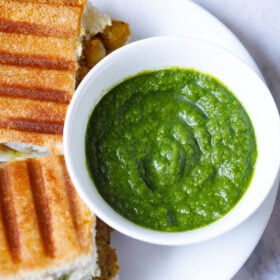
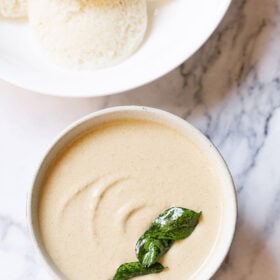
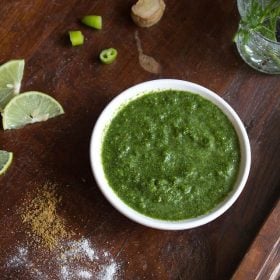
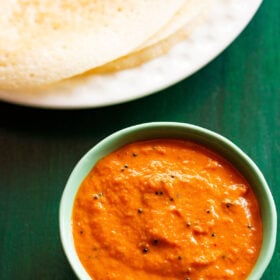
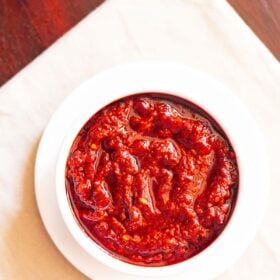
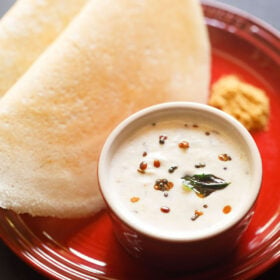








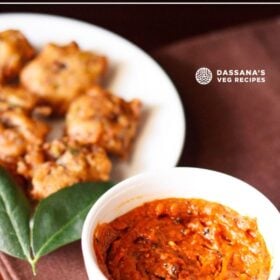
I had a craving and this hit just the spot! I used the 2nd recipe, and next time I will triple it. Thank you for sharing!!
Nice to know and thanks for sharing the lovely feedback. Most welcome.
I have been following you on Facebook for several years and have tried many of your recipes successfully. Thank you and Happy Christmas and New Year.
Robin
Thank you. Wish you Merry Christmas and Happy New Year.
I have loved this every time I make it and in-spite of making it now several times. I keep coming back to this recipe before i make it 😉
Happy to hear that! Thanks for the rating too.
Hi Dassana
You never know, how much indispensable service you are doing through your recipes. All recipes are practical, healthy, scientific. Your recipes are reflection of your true spirit.
Thanks so much. Glad to read your lovely comment. Thanks also for the rating on the recipe.
Superb, recipe! Much easier than my current one and just as good. I did add three tablespoons of ketchup, which gave a nice deep red color and also a sharp piquant taste! Thanks once again Dassana, I appreciate your instruction and the work you put into testing and presenting all your recipes. Nyle
Thanks a lot Nyle. Glad that you liked the recipe and also that the variation worked well. Thanks again and stay safe.
Just love your website new look and it is more convenient now to search recipes. Thanks dassana for awesome recipes
Thank you Ruchi. Glad that you have liked the new look of the website. Most welcome.
Hi,
This recipe seems really good.
I was wondering if we can freeze it(both versions) if yes,for how long?
Thank you in advance for your reply.
Warm regards,
D
Yes, you can freeze both the versions and will stay good for a couple of months in the freezer.
Thank you for your reply.
Warm regards,
D
Welcome D.
Please make fast and musical videos for your recipes for better understanding.
making professional quality videos takes a lot of time. maybe when i have a staff i can make videos. thanks for the suggestion priya. though for some recipes i have made videos and i have uploaded them on our youtube channel also.